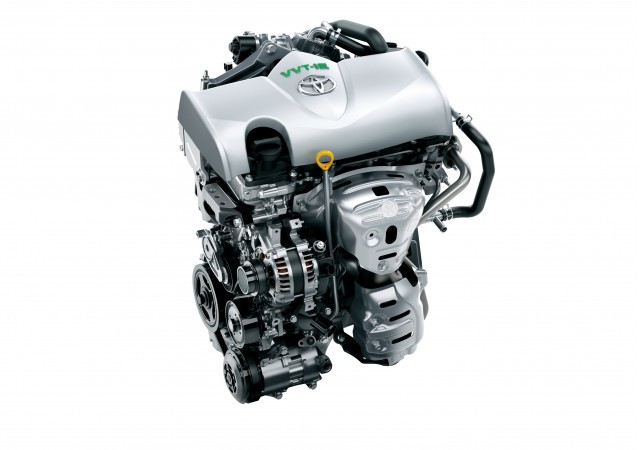
Toyota Motor Corporation is set to raise the fuel-efficiency bar in the automobile industry as it has announced plans to release a new powertrain for its vehicles in a few months.
To many new vehicle buyers, fuel efficiency is usually an important consideration. This is because the less fuel used the more money saved. Unarguably, Toyota ranks highest among top fuel-efficient brands; it offers many vehicles with impressive fuel economy.
Toyota is reported to have said the new powertrain was part of a five-year overhaul to make its vehicles more fuel-efficient and sportier to drive.
A report by an online journal, Automotive News, quoted the leading automaker as saying the engine wave would begin with a cleaner, more powerful 2.0-litre engine, appearing first in the redesigned Toyota Auris hatchback on display at the ongoing Geneva auto show. The Auris is the European and Japanese version of the Toyota Corolla.
The new engine is coming with a feature called Dynamic Force that delivers 18 per cent better fuel economy and 18 per cent faster acceleration when combined with a continuously variable transmission.
When mated to a hybrid system, the engine gets nine per cent better fuel economy and 18 per cent better speed off the line.
The new 2.0-litre engine achieves thermal efficiency rates of 40 to 41 per cent, compared with 37 to 38 per cent in the previous-generation engines.
The first Dynamic Force engine was the 2.5-litre four-cylinder that appeared last year in the redesigned Camry sedan.
Toyota said its engineers achieved the improvements through several tweaks, noting that they increased fuel-air turbulence in the cylinders for a faster burn.
Giving details about the new technology, Toyota said it was done using a technology typically reserved for Formula One racing engines known as laser cladding.
The result, according to the automaker, is a valve seat with a widened valve angle, which it believes is the first for mass-production cars.
“Other gains came from introducing direct fuel injection, optimising valve-timing control and using an electric water pump to reduce mechanical friction,” it stated.
By 2023, the new engines and transmissions are expected to power 80 per cent of new Toyota vehicles.
Fuel-efficiency
With the help of two All-Wheel-Drive systems, the engine is able to improve fuel efficiency, stability and off-road performance. The systems could be used in the SUVs, crossovers or even cars.
The first, called Dynamic Torque Vectoring AWD, is geared towards petrol vehicles and channels torque independently to the right and left wheels for better handling.
It also can disconnect drive rotation to the rear wheels in two-wheel-drive mode to boost fuel economy.
The version for hybrids, called E-Four, delivers 30 per cent more torque to the rear wheels compared with Toyota’s current AWD setup for hybrids.
Toyota also plans a six-speed manual transmission that is lighter, more compact and more efficient than the outgoing gearbox.
The efforts to get more fuel economy from its conventional internal combustion engines occur even as Toyota is said to invest in full electric technology.
Toyota, long perceived as an EV sceptic, announced in December that it planned to introduce more than 10 EVs worldwide by the early 2020s.
According to the automaker, the powertrain blueprint is its clear signal that it sees big potential for improving old-school internal combustion technology.
The Toyota’s Chief Engineer for Powertrain Planning, Mitsumasa Yamagata, says although some of the automaker’s nameplates should be electrified by 2030, many of its vehicles will continue to rely on fuel-burning powerplants.
He stresses that only 10 per cent of Toyota’s models will dump engines altogether in favour of full electric or fuel cell powertrains. Thus, Toyota’s key focus at the moment is improving the humble petrol powerplant.
“The evolution of engines and transmissions will also reduce carbon dioxide emissions and greatly contribute to the environment,” Yamagata said.
The firm says the new portfolio of engines and transmissions is accompanying an even bigger makeover for Toyota.
It states that it will be launching one nameplate at a time — what it calls its Toyota New Global Architecture modular vehicle platform around the world.
The TNGA, it says, will yield cars and trucks that are lighter and simpler to build and modify.
And to pair with all those newly designed vehicles, Toyota plans to introduce 17 versions of nine new engines by 2021. There also will be 10 versions of four new transmissions and 10 versions of six hybrid systems.
Meanwhile, Toyota has confirmed bookings of the Yaris will begin in April 2018. The launch is expected to happen in mid-2018. Once launched, the Yaris is expected to raise the sales figures for Toyota. The India-bound Toyota Yaris was first showcased at the Auto Expo 2018, according to a report by an online auto journal, Drive Spark.
The report notes the new C-segment offering from Toyota will face stiff competition from cars such as the Maruti Suzuki Ciaz, Skoda Rapid, Volkswagen Vento and the Honda City.
It says the Toyota Yaris will be available only with a 1.5-litre petrol engine, initially, adding that the power plant will be mated to either a 6-speed manual or a 7-speed CVT automatic gearbox.
For the interiors, the Toyota Yaris features an eight-way adjustable driver seat and also a 7-inch infotainment system with navigation and gesture controls.
The car also gets rain sensing wipers and cruise control options.
The car will be available in a range of colour options namely, Wildfire Red, Pearl White, Grey Metallic, Silver Metallic among others.
Toyota Motor Corporation is set to raise the fuel-efficiency bar in the automobile industry as it has announced plans to release a new powertrain for its vehicles in a few months.
To many new vehicle buyers, fuel efficiency is usually an important consideration. This is because the less fuel used the more money saved. Unarguably, Toyota ranks highest among top fuel-efficient brands; it offers many vehicles with impressive fuel economy.
Toyota is reported to have said the new powertrain was part of a five-year overhaul to make its vehicles more fuel-efficient and sportier to drive.
A report by an online journal, Automotive News, quoted the leading automaker as saying the engine wave would begin with a cleaner, more powerful 2.0-litre engine, appearing first in the redesigned Toyota Auris hatchback on display at the ongoing Geneva auto show. The Auris is the European and Japanese version of the Toyota Corolla.
The new engine is coming with a feature called Dynamic Force that delivers 18 per cent better fuel economy and 18 per cent faster acceleration when combined with a continuously variable transmission.
When mated to a hybrid system, the engine gets nine per cent better fuel economy and 18 per cent better speed off the line.
The new 2.0-litre engine achieves thermal efficiency rates of 40 to 41 per cent, compared with 37 to 38 per cent in the previous-generation engines.
The first Dynamic Force engine was the 2.5-litre four-cylinder that appeared last year in the redesigned Camry sedan.
Toyota said its engineers achieved the improvements through several tweaks, noting that they increased fuel-air turbulence in the cylinders for a faster burn.
Giving details about the new technology, Toyota said it was done using a technology typically reserved for Formula One racing engines known as laser cladding.
The result, according to the automaker, is a valve seat with a widened valve angle, which it believes is the first for mass-production cars.
“Other gains came from introducing direct fuel injection, optimising valve-timing control and using an electric water pump to reduce mechanical friction,” it stated.
By 2023, the new engines and transmissions are expected to power 80 per cent of new Toyota vehicles.
Fuel-efficiency
With the help of two All-Wheel-Drive systems, the engine is able to improve fuel efficiency, stability and off-road performance. The systems could be used in the SUVs, crossovers or even cars.
The first, called Dynamic Torque Vectoring AWD, is geared towards petrol vehicles and channels torque independently to the right and left wheels for better handling.
It also can disconnect drive rotation to the rear wheels in two-wheel-drive mode to boost fuel economy.
The version for hybrids, called E-Four, delivers 30 per cent more torque to the rear wheels compared with Toyota’s current AWD setup for hybrids.
Toyota also plans a six-speed manual transmission that is lighter, more compact and more efficient than the outgoing gearbox.
The efforts to get more fuel economy from its conventional internal combustion engines occur even as Toyota is said to invest in full electric technology.
Toyota, long perceived as an EV sceptic, announced in December that it planned to introduce more than 10 EVs worldwide by the early 2020s.
According to the automaker, the powertrain blueprint is its clear signal that it sees big potential for improving old-school internal combustion technology.
The Toyota’s Chief Engineer for Powertrain Planning, Mitsumasa Yamagata, says although some of the automaker’s nameplates should be electrified by 2030, many of its vehicles will continue to rely on fuel-burning powerplants.
He stresses that only 10 per cent of Toyota’s models will dump engines altogether in favour of full electric or fuel cell powertrains. Thus, Toyota’s key focus at the moment is improving the humble petrol powerplant.
“The evolution of engines and transmissions will also reduce carbon dioxide emissions and greatly contribute to the environment,” Yamagata said.
The firm says the new portfolio of engines and transmissions is accompanying an even bigger makeover for Toyota.
It states that it will be launching one nameplate at a time — what it calls its Toyota New Global Architecture modular vehicle platform around the world.
The TNGA, it says, will yield cars and trucks that are lighter and simpler to build and modify.
And to pair with all those newly designed vehicles, Toyota plans to introduce 17 versions of nine new engines by 2021. There also will be 10 versions of four new transmissions and 10 versions of six hybrid systems.
Meanwhile, Toyota has confirmed bookings of the Yaris will begin in April 2018. The launch is expected to happen in mid-2018. Once launched, the Yaris is expected to raise the sales figures for Toyota. The India-bound Toyota Yaris was first showcased at the Auto Expo 2018, according to a report by an online auto journal, Drive Spark.
The report notes the new C-segment offering from Toyota will face stiff competition from cars such as the Maruti Suzuki Ciaz, Skoda Rapid, Volkswagen Vento and the Honda City.
It says the Toyota Yaris will be available only with a 1.5-litre petrol engine, initially, adding that the power plant will be mated to either a 6-speed manual or a 7-speed CVT automatic gearbox.
For the interiors, the Toyota Yaris features an eight-way adjustable driver seat and also a 7-inch infotainment system with navigation and gesture controls.
The car also gets rain sensing wipers and cruise control options.
The car will be available in a range of colour options namely, Wildfire Red, Pearl White, Grey Metallic, Silver Metallic among others.

